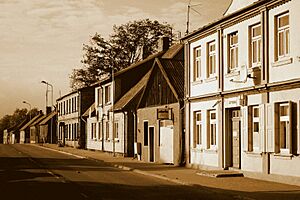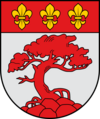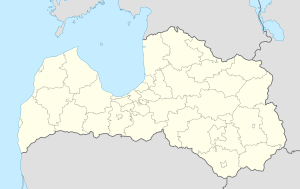Pāvilosta facts for kids
Quick facts for kids
Pāvilosta
|
|||
|---|---|---|---|
|
Town
|
|||

Houses on Dzintaru Street (Dzintaru iela)
|
|||
|
|||
| Country | |||
| District | South Kurzeme Municipality | ||
| Founded | 1879 | ||
| Town Rights | 1991 | ||
| Area | |||
| • Total | Lua error in Module:Wd at line 1,575: attempt to index field 'wikibase' (a nil value). km2 (Formatting error: invalid input when rounding sq mi) | ||
| • Land | Lua error in Module:Wd at line 1,575: attempt to index field 'wikibase' (a nil value). km2 (Formatting error: invalid input when rounding sq mi) | ||
| • Water | Expression error: Unexpected < operator. km2 (Formatting error: invalid input when rounding sq mi) | ||
| Population
(2024)
|
|||
| • Total | 851 | ||
| Time zone | UTC+2 (EET) | ||
| • Summer (DST) | UTC+3 (EEST) | ||
| Postal code |
LV-3466
|
||
| Calling code | +371 634 | ||
| Climate | Cfb | ||
| Website | http://www.pavilosta.lv/ | ||
Pāvilosta is a charming little port town in Latvia. It's located right where the Saka river meets the sea. In 2020, about 881 people lived there. Pāvilosta is part of the South Kurzeme Municipality in the Courland region.
Contents
A Look Back: The History of Pāvilosta
People have lived in the area of Pāvilosta since the Stone Age. Later, during the Iron Age, the Curonians lived here. They were an ancient Baltic tribe.
Early Port Days
The first mention of a port here was in 1253. It was called Sackenhausen. This small port belonged to different rulers over time. These included the Bishop of Courland and the Duchy of Courland. From 1795, it became part of the Russian Empire.
In 1879, a local landowner named Otto Friedrich von Lilienfeld started to rebuild the port. He named the new port town Paulshafen. This was in honor of his brother, Paul von Lilienfeld. Paul was a general governor in the area.
However, the town didn't grow as fast as planned. Not many buildings were built at first. The port was mostly used by a few fishermen. Some small sailboats from nearby manors also used it.
Growth and Ship Building
Pāvilosta really started to grow in 1893. This was when the Liepāja military port, called Karosta, began to be built. Pāvilosta became very important for moving stone to Liepāja. The port was changed to handle these stone shipments. Many builders, workers, and sailors came to Pāvilosta.
Even after the stone shipments stopped, Pāvilosta had a good port. It also had strong shipping services. Before First World War, there were three shipyards in town. They built small ships with one mast. Some bigger ships with two masts, called schooners, were also built. These schooners even went on international trips! In total, 15 ships were built in Pāvilosta. In 1913, Pāvilosta gained some town rights.
War and New Beginnings
During the First World War, the German Imperial Army took over Pāvilosta. The town was badly damaged. Most of Pāvilosta's ships were destroyed or taken away. After the war, only a few motorboats and sailors were left.
When Latvia became an independent country, Pāvilosta focused on fishery. In 1930, a group of fishermen formed a cooperative. In 1939, a Lutheran church was built in the town.
Soviet Times and Modern Day
After the Soviet occupation of Latvia in 1940, fishermen had to join together. They formed a group called an artel. During the Courland Pocket battles in Second World War, some families escaped. They fled from the Soviets to Gotland by motorboat.
After the war, Pāvilosta became a port town in the Latvian SSR. The local fishermen's artel used motorboats. In 1949, they bought their first fishing ship. In 1951, the artel became a kolkhoz called Dzintarjūra, which means "Amber Sea." Later, in 1975, this kolkhoz joined with a bigger one from Liepāja. By the 1970s, about 20 fishing trawlers used Pāvilosta port.
In 1991, Latvia became independent again. Pāvilosta was officially granted town rights that same year. Today, the port is mainly used by local fishermen. It's also popular with tourist yachts. There's even a school in town where you can learn sailing, surfing, and windsurfing!
Climate
Pāvilosta has an oceanic climate (Köppen Cfb). This means it has mild winters and warm summers. It's also very close to a humid continental climate (Köppen Dfb).
| Climate data for Pāvilosta (1991-2020 normals, extremes 1929-present) | |||||||||||||
|---|---|---|---|---|---|---|---|---|---|---|---|---|---|
| Month | Jan | Feb | Mar | Apr | May | Jun | Jul | Aug | Sep | Oct | Nov | Dec | Year |
| Record high °C (°F) | 9.4 (48.9) |
14.7 (58.5) |
18.7 (65.7) |
27.3 (81.1) |
30.2 (86.4) |
33.7 (92.7) |
33.4 (92.1) |
35.9 (96.6) |
30.5 (86.9) |
22.4 (72.3) |
15.9 (60.6) |
11.7 (53.1) |
35.9 (96.6) |
| Mean daily maximum °C (°F) | 1.2 (34.2) |
1.3 (34.3) |
4.3 (39.7) |
10.2 (50.4) |
15.1 (59.2) |
18.8 (65.8) |
21.5 (70.7) |
21.7 (71.1) |
17.3 (63.1) |
11.3 (52.3) |
6.0 (42.8) |
2.9 (37.2) |
11.0 (51.7) |
| Daily mean °C (°F) | −0.9 (30.4) |
−1.2 (29.8) |
1.2 (34.2) |
5.6 (42.1) |
10.3 (50.5) |
14.3 (57.7) |
17.3 (63.1) |
17.2 (63.0) |
13.2 (55.8) |
8.2 (46.8) |
3.9 (39.0) |
1.0 (33.8) |
7.5 (45.5) |
| Mean daily minimum °C (°F) | −3.5 (25.7) |
−4.0 (24.8) |
−2.2 (28.0) |
1.3 (34.3) |
5.4 (41.7) |
9.7 (49.5) |
12.7 (54.9) |
12.5 (54.5) |
9.1 (48.4) |
4.8 (40.6) |
1.5 (34.7) |
−1.4 (29.5) |
3.8 (38.9) |
| Record low °C (°F) | −32.0 (−25.6) |
−34.1 (−29.4) |
−23.1 (−9.6) |
−12.2 (10.0) |
−4.6 (23.7) |
−1.2 (29.8) |
2.1 (35.8) |
1.7 (35.1) |
−4.0 (24.8) |
−9.5 (14.9) |
−16.1 (3.0) |
−25.7 (−14.3) |
−34.1 (−29.4) |
| Average precipitation mm (inches) | 57.3 (2.26) |
46.7 (1.84) |
39.3 (1.55) |
31.6 (1.24) |
36.2 (1.43) |
50.8 (2.00) |
61.5 (2.42) |
80.6 (3.17) |
68.8 (2.71) |
91.1 (3.59) |
79.0 (3.11) |
72.0 (2.83) |
714.9 (28.15) |
| Average precipitation days (≥ 1 mm) | 13 | 10 | 10 | 7 | 6 | 8 | 8 | 10 | 11 | 14 | 15 | 13 | 125 |
| Source 1: LVĢMC | |||||||||||||
| Source 2: NOAA (precipitation days 1981-2010) | |||||||||||||
Images for kids
See also
 In Spanish: Pāvilosta para niños
In Spanish: Pāvilosta para niños








